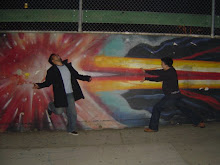Stance
There are many different kinds of stances ranging from "Iron" Mike Tyson's defensive but explosive Peek-a-boo stance, "Money" Mayweather's elusive counter-punching Hitman stance, to "Prince" Naseem Hamed's No-Guard stance, sacrificing defense to allow him to launch punches from unorthodox angles, and I will go over some of these stances later, but for now, I will go over the Orthodox Stance. This stance is a solid, fundamental, boxing stance that is very balanced between offense and defense.

The picture above shows a front and profile view of the orthodox boxing stance.
(A) The chin is tucked down, towards the chest. While this may feel uncomfortable at first, it is important because it prevents your opponent from landing and easy, clean punches your vulnerable chin.
(B) Your right hand is held at about eye level, with your palm facing towards you. This effectively covers the right side of your chin from attacks, and if you raise your right hand an inch or two, you will also protect your right temple from attacks, effectively guarding the entire right side of your face.
(C) Your elbows are pointed down and held close to your body. This is important for many reasons, one of which is that it protects your body from punches. If your opponent tries to punch you in the body, all you have to do is press your elbows tight against your body, greatly reducing any damage you would take to your body.
(D) Your left shoulder should be relaxed. Keeping your shoulder relaxed will allow you to punch easier, and not tire out quickly.
(E) Many coaches have different thoughts on your stance, with some saying to keep the feet shoulder-width apart, and some recommending wider than that. It's a matter of preference, but I personally like to keep my feet a little wider than shoulder width, because it allows more mobility for my upper body to avoid punches. If you consider your opponent in front of you to be at a 90 degree angle, the toes on your back foot should point at about a 30 degree angle and your front foot can vary, but should probably be around a 70 degree angle.
Note how the body is turned slightly to the side, causing your left hand to be in front, closer to your opponent, with your right hand back, further away from your opponent. Fighters who are right-handed generally fight in this stance, with their right hand (their power hand) in the back. Fighters who are left-handed, generally fight with their right hands in front, and their left hand (their power hand) back. These kinds of fighters are known as southpaws and are not as common as orthodox fighters. Notable southpaws include Manny "Pacman" Pacquiao and "Marvelous" Marvin Hagler. Some fighters who are left-handed choose to fight with their left hand forward, with notable examples Mike Tyson and Miguel Cotto.
Your knees should be slightly bent and you should be on the balls of your feet. In order to throw hard punches, it is sometimes required to plant your feet, but in general, it's is safer to be on the balls of your feet, ready to move if your opponent throws a punch.
Stance is very important in boxing as it is the foundation for all your punches and defense. The stance laid out here is the orthodox stance, but you can mix it up and change it however you want. The main things to focus on are to make sure that you can defend yourself from your stance and that you have proper balance in your stance, because balance is the key to throwing effective punches.

No comments:
Post a Comment